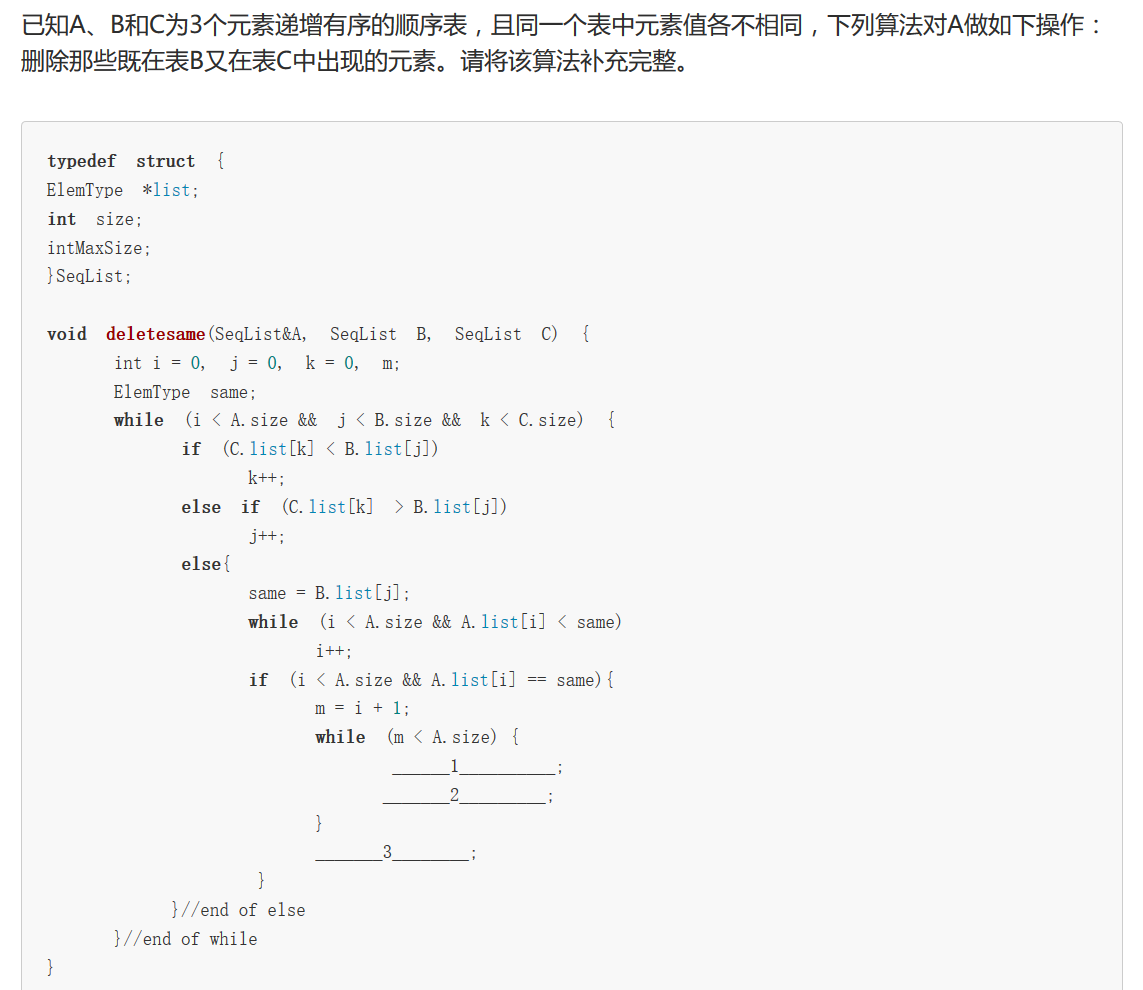学习了线性表之后发现删除的方式有多种多样,同时出题的方式也千奇百怪。
首先是最简单的删除:把要删除元素之后的元素全部往前挪,将欲删除的覆盖掉。
但是这种删除方式的局限性太大了,首先就是时间复杂度,这个算法的时间复杂度为O(n^2).

bool Delete( List L, Position P ) { int i; if(P>=L->Last||P<0) { printf("POSITION %d EMPTY",P); return false; } L->Last--;//这里的Last是指长度了 for(i=P;i<L->Last;i++) L->Data[i]=L->Data[i+1]; return true; }
这个算法遇到对时间有要求的情况基本就崩了。
例:
6-2 线性表元素的区间删除(20 分)
给定一个顺序存储的线性表,请设计一个函数删除所有值大于min而且小于max的元素。删除后表中剩余元素保持顺序存储,并且相对位置不能改变。
函数接口定义:
List Delete( List L, ElementType minD, ElementType maxD );
其中List结构定义如下:
typedef int Position;
typedef struct LNode *List;
struct LNode {
ElementType Data[MAXSIZE];
Position Last; /* 保存线性表中最后一个元素的位置 */
};
L是用户传入的一个线性表,其中ElementType元素可以通过>、==、<进行比较;minD和maxD分别为待删除元素的值域的下、上界。函数Delete应将Data[]中所有值大于minD而且小于maxD的元素删除,同时保证表中剩余元素保持顺序存储,并且相对位置不变,最后返回删除后的表。
裁判测试程序样例:
#include <stdio.h>
#define MAXSIZE 20
typedef int ElementType;
typedef int Position;
typedef struct LNode *List;
struct LNode {
ElementType Data[MAXSIZE];
Position Last; /* 保存线性表中最后一个元素的位置 */
};
List ReadInput(); /* 裁判实现,细节不表。元素从下标0开始存储 */
void PrintList( List L ); /* 裁判实现,细节不表 */
List Delete( List L, ElementType minD, ElementType maxD );
int main()
{
List L;
ElementType minD, maxD;
int i;
L = ReadInput();
scanf("%d %d", &minD, &maxD);
L = Delete( L, minD, maxD );
PrintList( L );
return 0;
}
/* 你的代码将被嵌在这里 */
输入样例:
10
4 -8 2 12 1 5 9 3 3 10
0 4
输出样例:
4 -8 12 5 9 10
由于这题有些函数需要裁判完成,我写了一个能测试的main函数
复制过去就能在编译器上测试了。

#include <stdio.h> #include <stdlib.h> #define MAXSIZE 20 typedef int ElementType; typedef int Position; typedef struct LNode *List; struct LNode { ElementType Data[MAXSIZE]; Position Last; /* 保存线性表中最后一个元素的位置 */ }; List Insert( List L, ElementType X, Position P ); List ReadInput(); /* 裁判实现,细节不表。元素从下标0开始存储 */ void PrintList( List L ); /* 裁判实现,细节不表 */ List Delete( List L, ElementType minD, ElementType maxD ); List MakeEmpty(); int main() { List L; ElementType minD, maxD,N,X=0,P; int i; scanf("%d", &N); L=MakeEmpty(); while ( N-- ) { scanf("%d",&P); L=Insert(L, X, P); X++; } L->Last--; // for(i=0;i<L->Last;i++) // printf("%d ",L->Data[i]); scanf("%d %d", &minD, &maxD); L = Delete( L, minD, maxD ); for(i=0;i<=L->Last;i++) printf("%d ",L->Data[i]); return 0; } List MakeEmpty() { List ptr; ptr=(List)malloc(sizeof(struct LNode)); ptr->Last=0; return ptr; } List Insert( List L, ElementType X, Position P ) { if(!L)return false; int i=0; L->Data[X]=P; L->Last++; return L; } /*你的代码插在这*/
这里有一个很重要的点这里的L->Last是下标!!!
此题有多种解法,我先列出三种
1.会超时的,也就是刚才的删除法
List Delete( List L, ElementType minD, ElementType maxD ) { int i=0,j; if(!L)return L; if(minD>=maxD)return L; while(i<=L->Last) { if(L->Data[i]<maxD&&L->Data[i]>minD) { L->Last--; for(j=i;j<=L->Last;j++) { L->Data[j]=L->Data[j+1]; } } else i++; } return L; }
2.第二种算法的思路就是,建立一个辅助数组,将不想删除的数记录下来,遍历完一次数组过后,在将数组的内容抄录到线性表中,
同时L->Last的大小也变为不想删除的数的个数。
虽然这算法使时间复杂度变为O(n)了,但是这种算法的局限性是多定义了一个数组,导致空间复杂度变大。
List Delete( List L, ElementType minD, ElementType maxD ) { int i=0,count=0; if(!L)return L; if(minD>=maxD)return L; int a[L->Last+1];//辅助数组 while(i<=L->Last) { if(L->Data[i]<=minD||L->Data[i]>=maxD) { a[count]=L->Data[i]; count++;//记录个数 } i++; } L->Last=--count;//L->Last是下标,所以,减少一个 for(i=0;i<=count;i++) L->Data[i]=a[i]; return L; }
3.这是问其他人后得知的(感谢感谢他)
思路是:
遍历一遍数组,遇到要删除的元素把数量记录下来,遇到不删除的元素前移,覆盖掉要删除的元素。结束后整个长度剪掉删除数就好了。
假定我需要删除1 4中的元素(不包括1和4哦)


代码:
List Delete( List L, ElementType minD, ElementType maxD ) { int i=0,count=0; if(!L)return L; if(minD>=maxD)return L; for(;i<=L->Last;i++) { if(L->Data[i]>minD&&L->Data[i]<maxD) count++;//计算数量 else L->Data[i-count]=L->Data[i];//往前挪动 } L->Last-=count;//长度变短 return L; }
还有两题课后练习题,也挺有意思的。



